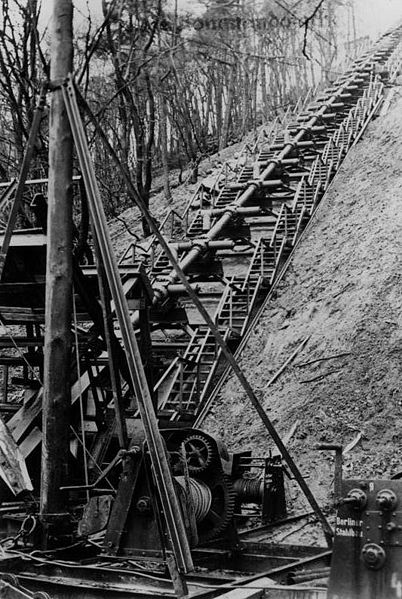Drawing and Test Bed for HDP Gun.
V-3 Projectile
In 1870 two Americans, Lyman and Halskell came up with a novel idea which, like all such novel ideas, appeared theoretically impeccable. They proposed a long-barrelled gun which would have the usual chamber at the back end for the propelling charge, but would also have a number of auxiliary chambers connected to the gun barrel, each of which would be loaded with an additional charge. A shell would be loaded and the first charge fired in the normal manner; then, as the shell passed the entrance to the first auxiliary chamber, the charge therein would be fired, adding more gas and more propulsive power to the shell; and as the shell passed each of the other chambers, so their charges would fire, until the shell had been boosted to whatever velocity the designer wished after which it would travel up the rest of the gun barrel before emerging at a very high velocity so as to attain a much greater range than would be possible with a normal gun.
The Lyman & Haskell gun was built and test-fired at Frankfurt arsenal, but the results were at variance with the theory. Instead of emerging at high velocity the shell actually achieved only 335 m/sec (1100 ft/sec), much worse than an ordinary Armstrong gun of the same caliber. At the same time, the pressure in the barrel reached a massive 36 tons/sq in (5670 kg/sq cm)., which should helve delivered more velocity. Eventually it was discovered that the flame from the first cartridge was washing over the shell and igniting the auxiliary charges too soon, so that instead of boosting the shell they were actually impeding it. After some more experiments, which did nothing to improve the design, the Lyman & Haskell gun was dropped.
But in later years other people rediscovered the idea, and proposed it. As recently as 1938 a Czech called Lugendhat offered the British government his Multiplex Gun, which was the same idea, and duly had it turned down. One of Lugendhat’s most intriguing details, though, was his suggestion that it should be extremely long and instead of mounting it on any sort of carriage, it was to be concreted into a hillside in order to give it support.
Whether Lugendhat offered his ideal elsewhere is not known, but at much the same time a German engineer named Conders began experimenting along the same lines. Conders was the Chief Engineer of the Rochling Stahlwerk AG, who held produced a number of fin-stabilized anticoncrete shells for conventional guns and it would seem likely that Conders was trying to find a way of delivering these shells at high velocity over long ranges. By May 1943 he had built and fired a 2-cm (0.79-in) scale model of a multiple-chambered gun and, via Reichsminister Speer, he received Hitler’s blessing for the ideal. A full-sized gun in 15-cm (5.9-in) caliber was designed, and it was planned to build a complex of 50 barrels, each 150 m (492 ft) long dug into a hillside and aimed at London.
The original plan was to fire the auxiliary charges electrically, but this was dropped in favour of allowing the flash behind the shell to do the ignition. While work went ahead near Calais in building the ‘High Pressure Pump’, as it was codenamed, a prototype gun was built at Misdroy, on the Baltic, for experimental firing and to train crews. Special fin-stabilized shells were manufactured by the thousand.
Unfortunately the project went awry. The prototype gun repeatedly blew up, while the giant installation at Calais was detected and subjected to intense aerial bombing. Eventually the Calais area was captured by Allied troops and the installation, after careful examination was demolished. Two shortened versions of the Conder gun were produced and were to have been put into action and to have fired rounds at Luxembourg in December, 1944. The guns were not particularly effective; from the 142 rounds that landed in Luxembourg, total casualties were 10 dead and 35 wounded. One gun was dismantled on 15 February, 1945, and firing ceased on 22 February, when US Army units had advanced to within 3 kilometres (1.9 mi) of the Lampaden site.
The basic defect of the multiple-chamber gun is simply the question of timing the ignition of the auxiliary charges. Even with perfect electrical ignition., the charge does not build up its force for about 0.020 of a second., and in that short space of time the projectile will have moved some 15-20 m (50- 65 ft) in the barrel. So that except by placing the chambers at impractically great distances apart, the multiple charges cannot be controlled. Further, there is an element of erosive wear at the mouths of the auxiliary chambers which leads to irregular gas flow, and this, in turn, leads to sporadic peaks of high pressure in the bore as the various gas impulses meet and combine. Even so, there is no doubt that another inventor will come up with the idea in the future.
